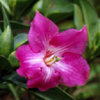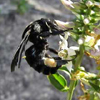|
Ecology and natural history of gentians:
plant-animal interactions |
 |
|
|
Listed below are some traits that occur in the family and their occurrence in investigated genera. Bibliographic references are listed in brackets [ ] after the characters. See also Morphology and Anatomy.
Ecology and population biology: saprophytic habit, mycotrophy: Three tropical genera in the Gentianaceae are completely without chlorophyll: Cotylanthera, Voyria, and Voyriella. There are also reports of a mycotropic habit in one species of Sebaea, Bartonia, and Obolaria, but these three genera retain some chlorophyll in their cells.
Pollination: buzz-pollination by bees: Buzz-pollination is known from Chironia in South Africa; a plant that has anthers that only open at the top to let the pollen out (similar to the buzz-pollinated anthers of Solanum, the potato genus, in the family Solanaceae). Carpenter bees have visited flowers of Coutoubea (A. Popovkin, pers. obs.). bumblebees:
The North American bottle gentians (Gentiana
andrewsii and a few other species) have tubular, often closed
flowers, that are forced open and pollinated by bumblebees (Costelloe,
1988).
Bumblebees also visit more open Gentiana flowers, such as Gentiana
puberulenta. beetles: hummingbirds: Hummingbirds visit the flowers of Symbolanthus pulcherrimus in Panama and Macrocarpaea noctiluca in Ecuador [L. Struwe, personal observation). Other gentians that probably at least partly hummingbird pollinated includes Lagenanthus, Lehmanniella, Lisianthius, Potalia, and Purdieanthus. moths: Moth-pollination has been recorded in Macrocarpaea sodiroana in Ecuador [J-M Torres, personal observation] (photos, link). bats: Chelonanthus alatus (earlier synonym Irlbachia alata) from the Amazon Basin, South America, is pollinated by bats [Machado et al., 1998]. Possible bat-pollinated flowers occur also in Macrocarpaea and Symbolanthus.
Other plant-animal interactions: ants and nectaries: Ants visit the calyces of Fagraea racemosa (photo) and the glandular base of the petioles of Anthocleista (photo). Tachia has hollow stems and ants often lives inside the woody stems. Animals and other organisms that eat and attack gentians, see this page.
Fruit and seed dispersal: mammals: Mammal-dispersal of fruits has been reported from Fagraea and Anthocleista. bats: In tropical Africa, Anthocleista trees are often visited by hammerhead bats that feed on the fruits. birds: Some species of Fagraea are dispersed by birds. wind: Several species of Voyria has tiny and long, thread-shpaed wind-dispersed seeds. In Gentiana and Gentianella some species have upright capsules on stiff stalks, that rattle in the wind - thereby causing the seeds to shake out and disperse farther away than if they would just fall down close to the mother plant. rainwash: A few Voyria species with round seeds might use rainwater as dispersal agent.
Plant pathology and to find out what eats gentians, see the pest page
Vogel, S. 1969a. Chiropterophilie in der neotropischen Flora. Neue Mitteilungen II, II. Spezieller Teil (Fortsetzung). Flora, Abt. B, 158: 185-222. Vogel, S. 1969b. Chiropterophilie in der neotropischen Flora. Neue Mitteilungen III, II. Spezieller Teil (Fortsetzung). Flora, Abt. B, 158: 289-323.
spp. = some species
© Lena Struwe, 2004-2011. |
||

